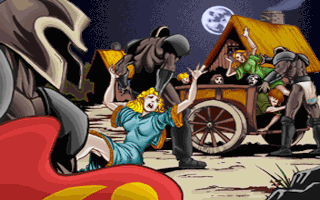
One of the things I like about looking at older video games is that it gives an opportunity to see the early experiments of the medium. Rogue Entertainment’s Strife is both one of the last games to use the Doom engine and one of the first FPS games to use RPG conventions like improving skills, an involved, branching narrative, and conversations with NPCs. It even has some rudimentary “stealth” mechanics. Everything is rough around the edges, but there’s something intriguing about seeing these foundations take form.
The basic story setup for Strife is that an alien spaceship (mistaken for a meteor) crashed on top of a pseudo-medieval society, releasing a mutating virus that ravaged the population and allowed an alien entity to mind control and technologically bootstrap a fascistic faction into ascendance. The Order, as the aforementioned faction is called, then proceeds to oppress everyone else into slave labor and steal all the women and children they can get their hands on for lethal experiments, forcing the rest of them underground and effectively damsel-ing the entire female half of the human race so that the developers don’t have to make female character models or hire more than one female voice actor. You play as an unnamed mercenary working for the resistance, known as The Front, as a general troubleshooter and hatchet man. With the assistance of Blackbird, your mission control and solitary female character (who, of course, shows up to kiss you in the end if you get the best ending), you slowly dismantle The Order and uncover the alien plot lying underneath it. There is a single major branch about midway through the narrative which determines your path for the rest of the game and the ending you get. There are also a few side missions, which are not necessary to complete the game, but reward you with additional stats or weapons.
In terms of gameplay, Strife largely follows the course of other FPS games of the era. The challenge of the game ultimately lies in resource management as opposed to assaulting a series of set pieces. The rank and file enemies that make up the majority of the game are not particularly threatening; they are easily killed and are not capable of doing much damage to you. Inevitably, however, they will score some hits on you before you are able to kill them, forcing you to use up medical supplies in addition to the ammo spent killing them. In addition to scavenging supplies from the environment, you are rewarded with gold at certain points that can be spent to buy more ammo, medkits, and armor, but none of these resources are renewable. Eventually, you will come to a boss fight, the difficulty will spike massively, and you’ll be forced to pop medkits like candy in order to stay alive, making your ability to conserve resources between boss fights critical. Ultimately, the resource it all comes down to is your health, especially considering that a class of bosses (including the final boss) can only be hurt by a weapon that uses your health as ammunition.
The more RPG-esque gameplay elements come back into play with your character’s stats and the game’s attempt at a stealth mechanic. Recognizing that the only things that matter in an FPS are your ability to kill enemies and stay alive, the only improvable stats in the game are accuracy, which tightens the spread of the Assault Gun, and stamina, which increases your maximum health. These stats generally improve at plot milestones, after which you will be given vouchers that can be taken to the shooting range and the medic. This is very rudimentary by RPG standards, but at least it avoids the often-committed FPS-RPG sin of tempting you to spend limited skill points among a big group of ultimately useless skills. The stealth mechanic is really more of an alarm mechanic. In numerous sections of the game, you are infiltrating some Order facility using falsified credentials or a stolen uniform. As long as the alarm isn’t raised, most enemies won’t attack you. The alarm will be raised if you cross certain gates, which you inevitably must in order to progress through the level, or if you fire most weapons. There’s no point in the game where you can really get in and out without raising an alarm, as there will always be some kind of alarm gate eventually, and many of the later levels include robotic enemies that will attack you on sight, alarm be damned. At the same time, you can take advantage of silent weapons like the punch dagger or poisoned crossbow bolt, which will not set off an alarm even if you kill someone with them in plain view, to thin out the opposition ahead of time. And if nothing else, it gives you the feeling of being something of an infiltrator, which helps sell the Order as a superior force better than if you were just going from one zone to another with guns ablaze.
In the grand scheme of things, Strife has probably been much less influential on the development of the FPS-RPG than, say, System Shock or Ultima Underworld, but I think it’s useful to look back and see the less successful experiments, as opposed to simply collating the best of the best into hall of fame lists. It’s important to remember not just what worked well in the best examples, but what didn’t quite work in the honorable mentions. It can either be a caution against things which don’t work, or an overlooked gem waiting to be polished.




